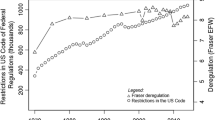Abstract
While cross-subsidization is understood theoretically as involving the sustainability of a cost allocation scheme, it is invoked in regulatory policy contexts, such as the divestiture of AT&T, where costs of serving unregulated markets may be borne by ratepayers of regulated monopolies. We analyze two cross-subsidization tactics—cost misallocation and distorted technological choice — under a spectrum of regulatory cost allocation policies. These tactics lead to higher prices in regulated markets and inefficient production in unregulated markets. Welfare effects are discussed; we conclude with observations on strategic behavior and regulatory policy.
Similar content being viewed by others
References
Averch, H. and L. Johnson, 1962. “Behavior of the Firm under Regulatory Constraint.” American Economic Review 52: 1052–69.
Bailey, E. and A. Friedlander. 1982. “Market Structure and Multiproduct Industries.” Journal of Economic Literature 20: 1024–48.
Baseman, K. 1981. “Open Entry and Cross-Subsidization in Regulated Markets.” In Studies in Public Regulation, edited by G. Fromm. Cambridge, MA: MIT Press.
Baseman, K. and S. Silberman. 1986. “The Economics of Bell Operating Company Diversification in the Post Divestiture Telecommunications Industry.” ICF Incorporated.
Baumol, W. 1982. “Contestable Markets: An Uprising in the Theory of Industry Structure.” American Economic Review 72: 1–15.
Baumol, W., E. Bailey and R. Willig. 1977. “Weak Invisible Hand Theorems on the Sustainability of Multiproduct Natural Monopoly.” American Economic Review 67: 350–65.
Baumol, W. and A. Klevorick. 1970. “Input Choices and Rate-of-Return Regulation: An Overview of the Discussion.” Bell Journal of Economics and Management Science 1: 162–90.
Becker, G. 1968. “Crime and Punishment: An Economic Approach.” Journal of Political Economy 76: 169–217.
Berg, S. and J. Tschirhart. 1988. Natural Monopoly Regulation: Principles and Practice. Cambridge: Cambridge University Press.
Bittlingmayer, G. 1982. “Decreasing Average Costs and Competition: A New Look At the Addyston Pipe Case.” Journal of Law and Economics 25: 201–229.
Breautigam, R. 1979. “Optimal Pricing with Intermodal Competition.” American Economic Review 69: 38–49.
Braeutigam, R. and J. Panzar. 1988. “Diversification Incentives Under ‘Price-Based’ and Cost-Based' Regulation,” mimeo, Northwestern University.
Brennan, T. 1987a. “Why Regulated Firms Should Be Kept Out Of Unregulated Markets: Understanding the Divestiture in U. S. v. AT&T.” Antitrust Bulletin 32: 741–93.
Brennan, T. 1987b. “Cross-Subsidization and Discrimination by Regulated Monopolists.” Economic Analysis Group discussion Paper 87-2, Antitrust Division, U.S. Dept. of Justice.
Brennan, T. 1989a. “Regulating by Capping Prices.” Journal of Regulatory Economics 1: 133–47.
Brennan, T. 1989b. “Divestiture Policy Considerations in an Information Services World.” Telecommunications Policy, forthcoming.
Brock, W. 1983. “Pricing, Predation, and Entry Barriers in Regulated Industries.” In Breaking Up Bell: Essays in Industrial Organization and Regulation, edited by D. Evans. New York: North Holland.
Brock, W. and D. Evans. 1983. “Creamskimming.” In Breaking Up Bell: Essays in Industrial Organization and Regulation, edited by D. Evans. New York: North Holland.
Crew, M. and K. Crocker. 1987. “Diversification and Regulated Monopoly.” GSM Working Paper #87-001, Graduate School of Management, Rutgers University.
Department of Justice, Antitrust Division. 1982. “United States v. Western Electric Company, Inc., and American Telephone and Telegraph Company; Competitive Impact Statement in Connection With Proposed Modification of Final Judgment.” Federal Register 47: 7170–84.
Faulhaber, G. 1975. “Cross-Subsidization: Pricing in Public Enterprise.” American Economic Review 65: 966–77.
Faulhaber, G. 1987. Telecommunications in Turmoil. Cambridge, MA: Ballinger.
Fowler, M., A. Halprin and J. Schlichting. 1986. “‘Back to the Future’: A Model for Telecommunications.” Federal Communications Law Journal 38: 145–200. FPC v. Hope Natural Gas Co., 320 U.S. 591 (1944).
Lewis, T. and D. Sappington. 1989. “An Informational Effect When Regulated Firms Enter Unregulated Markets.” Journal of Regulatory Economics 1: 35–46.
Panzar, J. 1986. “Economic Perspective on Regulated Integration.” Telecommunications Policy Research Conference.
Panzar, J. and R. Willig. 1977. “Free Entry and the Sustainability of Natural Monopoly.” Bell Journal of Economics 8: 1–22.
Sappington, D. and J. Stiglitz. 1987. “Information and Regulation.” In Public Regulation: New Perspectives on Institutions and Policies, edited by E. Bailey. Cambridge, MA: MIT Press.
Sharkey, W. 1982. The Theory of Natural Monopoly. Cambridge: Cambridge University Press.
Spence, A. M. 1977. “Entry, Capacity, Investment, and Oligopolistic Pricing.” Bell Journal of Economics 8: 534–44.
Sweeney, G. 1982. “Welfare Implications of Fully Distributed Cost Pricing Applied to Partially Regulated Firms.” Bell Journal of Economics 13: 525–33.
Temin, P. 1987. The Fall of the Bell System. New York: Cambridge University Press.
United States v. American Telephone & Telegraph, 552 F. Supp. 131 (1982).
Author information
Authors and Affiliations
Rights and permissions
About this article
Cite this article
Brennan, T.J. Cross-subsidization and cost misallocation by regulated monopolists. J Regul Econ 2, 37–51 (1990). https://doi.org/10.1007/BF00139361
Issue Date:
DOI: https://doi.org/10.1007/BF00139361




